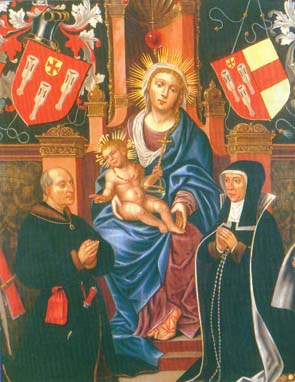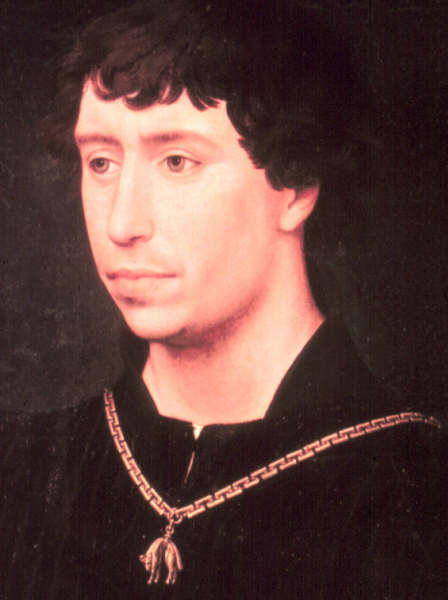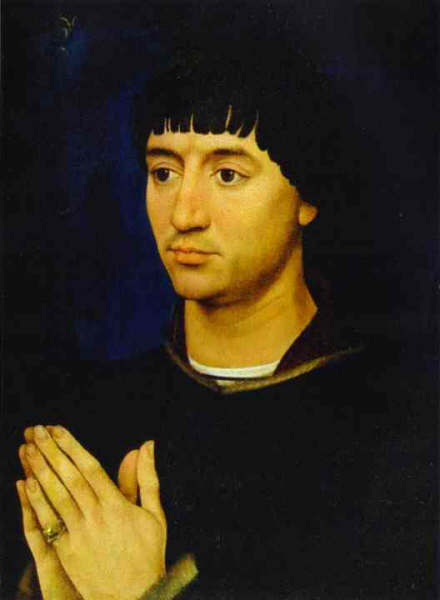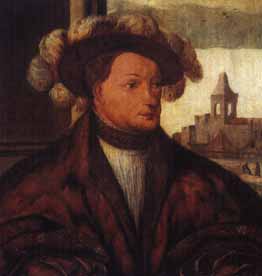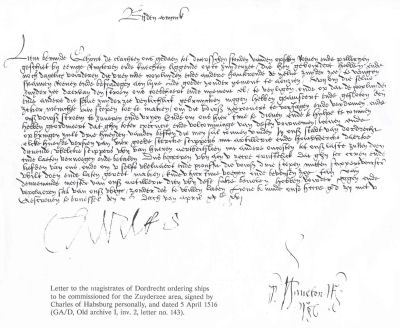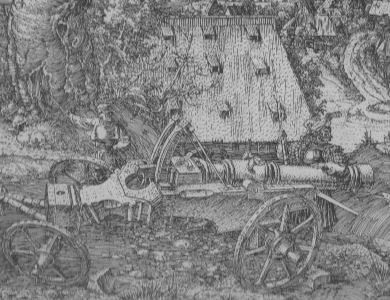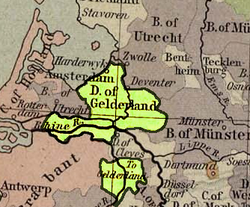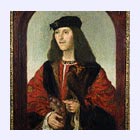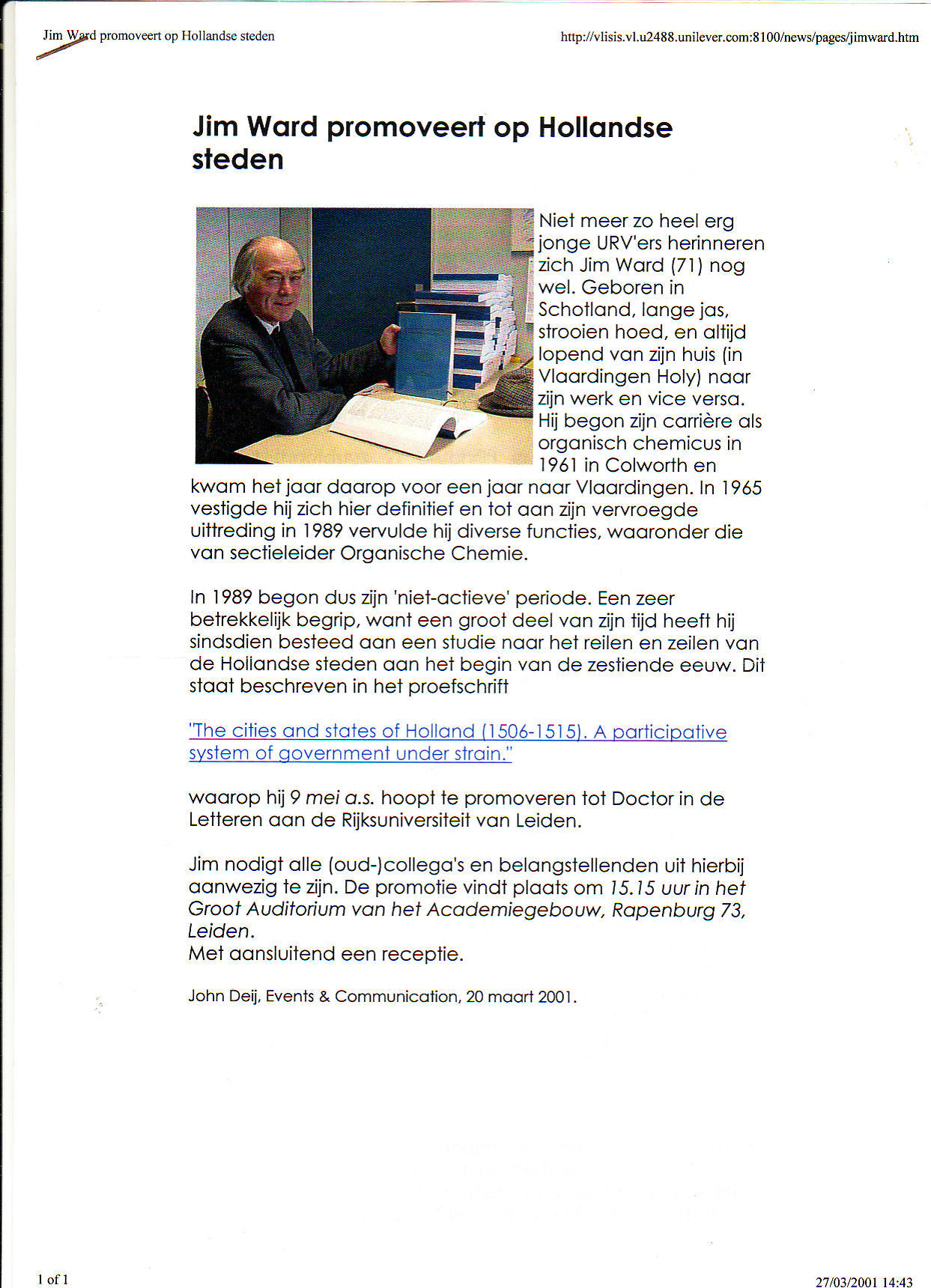RECENTLY RECOVERED
WRITINGS OF DR CHRISTINA CRUICKSHANK MILLER
(1899-2001)
James P. Ward
This article contains three recently found additions to the 21 letters of Dr Christina Cruikshank Miller to me, which I published earlier on my website james.wardware.com
Addendum 1: A letter on ‘airmail’ paper.
Edinburgh EH 11 1LN
Scotland
14 January 1990
Dear Jim,
I was delighted to receive your letter of 16 December on 3 January. We had of course no deliveries on 25 and 26 December and 1 and 2 January, and there has been a hold up somewhere. Although I started my “end of year” correspondence in late Oct. I soon got tired of it and had a breather, which resulted in the usual rush to complete operations by 19 December for delivery before Christmas. In the end I failed by two letters, one long, yours, as I had written to you on 14/3/89. In future I’ll have to write more letters during the year instead of at Christmas. There is something to be said for collecting data from all sources and then disseminating the news.
It is good to know that you got your pension arrangements sorted out, as it was essential to know where you stood before retiring. Apparently you are more than satisfied, which must be a great relief.
By this time you will be a confident student, having adequately passed the test during Term I. Congratulations on your good marks. Do you study in the train morning and evening? In 1920 when I saw Sir James Walker about doing a Ph.D. under him he told me to get up German during 1920-21 when I had to attend the Heriot-Watt in order to complete my 4-year course there. That year I traveled daily from Kirkcaldy and studied German in the train via [sic] Hugo’s well known [sic] course. So the train journeys involved no waste of time. Incidentally, I got up Dutch via a Hugo course before going to a glass blowing course at Leiden in 1926!
I’d like to know more about your degree course. What kind of history you are studying and what the additional classes are. Presumably all lectures are in Dutch, but you must have mastered the language long ago. You don’t mention how Miriam is getting on with her English literature course, but I hope she has got well dug in, although daily travel is rather tiring. One year was enough for me.
So Frans has taken the plunge and married his Yvonne. The wedding would be the chief excitement for 1989. Is Frans still studying at evening classes for the qualification in Information Technology or has he now collected it? I suppose Yvonne will be at work too as is the norm in these days. Has Michael got down to doing something worthwhile for a living?
I deduce that 1989 has been a happier year, for you left Unilever feeling you had achieved a lot of good work on the research side. A total of 50 publications, especially in industry, is something to be proud of.
You will be interested to know that I reached nonagenarian status in August. I was not amused and made no plans to celebrate, having no family to participate. However, there were surprises. At 11 a.m. on the day Drs R. & B. Gould came from K. B. with a beautiful basket of flowers as a gift from Chem. Dept. Accompanying it was a kind appreciative letter from Prof. Ramage, Head of the Dept, whom I have [‘not’ erased] never met. In the afternoon, Dr Anderson’s wife, Joan, and youngest daughter, Judy, who bears my name as her third forename, arrived with a luscious birthday cake (home baked), with which we had a nice birthday tea. Several people had somehow got wind of the occasion, resulting in my receiving 21 cards, instead of the usual 7 or 8, and several small gifts. Prof. Campbell, who has the same birthday but is 4 years younger, was in Pitlochry with his wife for his celebration. They called to see me after their return home, both looking very well. Their younger son announced his engagement a month or two ago to a Linlithgow lady – wedding in April. The Campbells are due to celebrate their golden wedding in I think, May but I don’t know the exact date. In my financial records I found that I had contributed to a departmental gift in the week ending 12 May 1940! I must endeavor to find out the exact date.
Sundry ex EU friends, covering graduation years 193-1958, have been here during 1989. Evelyn Hay called in May, feeling renewed in health after a holiday in Morocco and her now easier lifestyle. She now has a flat with a sun balcony in South Oswald Road, off Blackford Avenue, and likes it very much. Winnie Stafford retired in September, as expected, and is likewise enjoying her freedom. An unexpected visitor was Dr R. F. Neale (1955) [error‘1954’ corrected], who came as representative of Dr Myra Rennie (née MacDougall) who was on a short visit to her mother in a Trinity retirement home and had insufficient time to see me. You demonstrated to both. Frank retired early from B.P. Grangemouth and now lives in Balerno, sometimes doing a little work in H-W Univ. After the closure of Stirling Univ. Chem. Dept, Prof. J.M. G. Cowie was transferred to H.-W. where he has got a new chair in Materials Science. Myra has a very exacting job as headmistress of a privately run school for girls (boarders and day) in Derbyshire, yet enjoys the challenge. John Hunter looks in occasionally. His adopted boys are now 18 ½ and 17, the younger carrying on at school to take Highers. The older boy goes from one job to another and does not seem to know what he wants to do, which is a bit worrying.
The McDowells (Dr E. Percival) called in June while visiting family in the city. They were going North afterwards to Kyle of Lochalsh where they had very good weather suitable for many lovely walks. Elizabeth was 84 a week or so ago and is still very active. I had Dr Beevers along for tea one day. He does approximately half time work at K. B. and enjoys it. Dr Ritchie’s widow and Dr Betty MacBean (1942) were here in Sept. together from Peebles. The latter did her Ph. D. with Prof. Campbell and was eventually appointed as a lecturer and to be my understudy on Adv. Lab. However, to my great regret she soon left to marry. Her older brother, Ian Barclay (1936), and his wife from Bridlington appeared unannounced one day. He was a forensic chemist in Harrogate and had a lot to do in connection with the Moors Murders, work that he found very horrible.
My Inverness friend brought greetings from Andrew Stanners in Kingussie. Elinor is married and living in West Calder, John is a school lab technician at Culloden Academy, and Adam an architect in Glasgow. Jim Headridge has a variety of ploys in Sheffield including giving courses of lectures in the Polytechnic. His wife got a B. Ed. degree at Cardiff and does part-time teaching. The elder girl is married and teaching. Jim and Anne have a fancy to go abroad to teach, but each has an elderly mother to consider. Hans Ehrlich is very busy in his firm in Essex and has to find time to visit his mother who is alone in Germany but now in a home for old people, as she had a stroke that affected her memory. The three Ehrlich boys have all got degrees now and also jobs but none is yet married. George Charalambous is determined to go on as long as he can. Last year he was associated with a conference in Crete which was very successful. He is now a grandpa, his son having got a daughter. George’s daughter was married during the year. The Knox clan is increasing rapidly, twin grand-daughters and a grandson last year.
Since I last wrote, the severity of the tinnitus that has plagued me for 30 years has not diminished and my balance has worsened. Between the two I feel very unstable and find walking outside for more than a short distance most unpleasant and indeed precarious. With general muscular arthritis added, I have to be extremely cautious. I have not ventured on a bus for months and am reduced to walking to the shops nearby, whereas I used to manage Bruntsfield. Being so alone in the world, I try to avoid all risks. However, I still cope in this flat and pay proper attention to meals. I shall doubtless have to get a home help before long. Everybody tells me to buy all the help I can get before contemplating going into a nursing home, which I am definitely not doing yet. I have reached the conclusion that it is best to live a day at a time.
This year I have lost my chief holiday chum whom I met at H.-W. College in 1918, and my oldest friend with whom I started school at Hawick in 1905. The former died in April, completely senile, the later virtually helpless but mentally alert in late November. Did you know Heather Alexander (1954)? I was shocked to read of her death on Good Friday. A cousin informed me that she had known she had inoperable cancer that would soon prove fatal.
Are you getting reassuring news about your mother and is she still able to live on her own, having a son and a daughter able to look in at intervals? I am very thankful that my memory loss is not yet one of my problems and I hope it never will be. Has your brother recover from the shock of being 50?
How does Jetty occupy her time when you are all out of the house? I know she plays a lot of bridge but I seem to recall that she likes painting. You won’t have much time for music just now
Very best wishes to you, Jetty, the family for 1990.
And kindest regards from
Chrissie Miller.
Addendum 2: A Simon Elvin illustrated letter card, showing an address book together with a vase with roses.
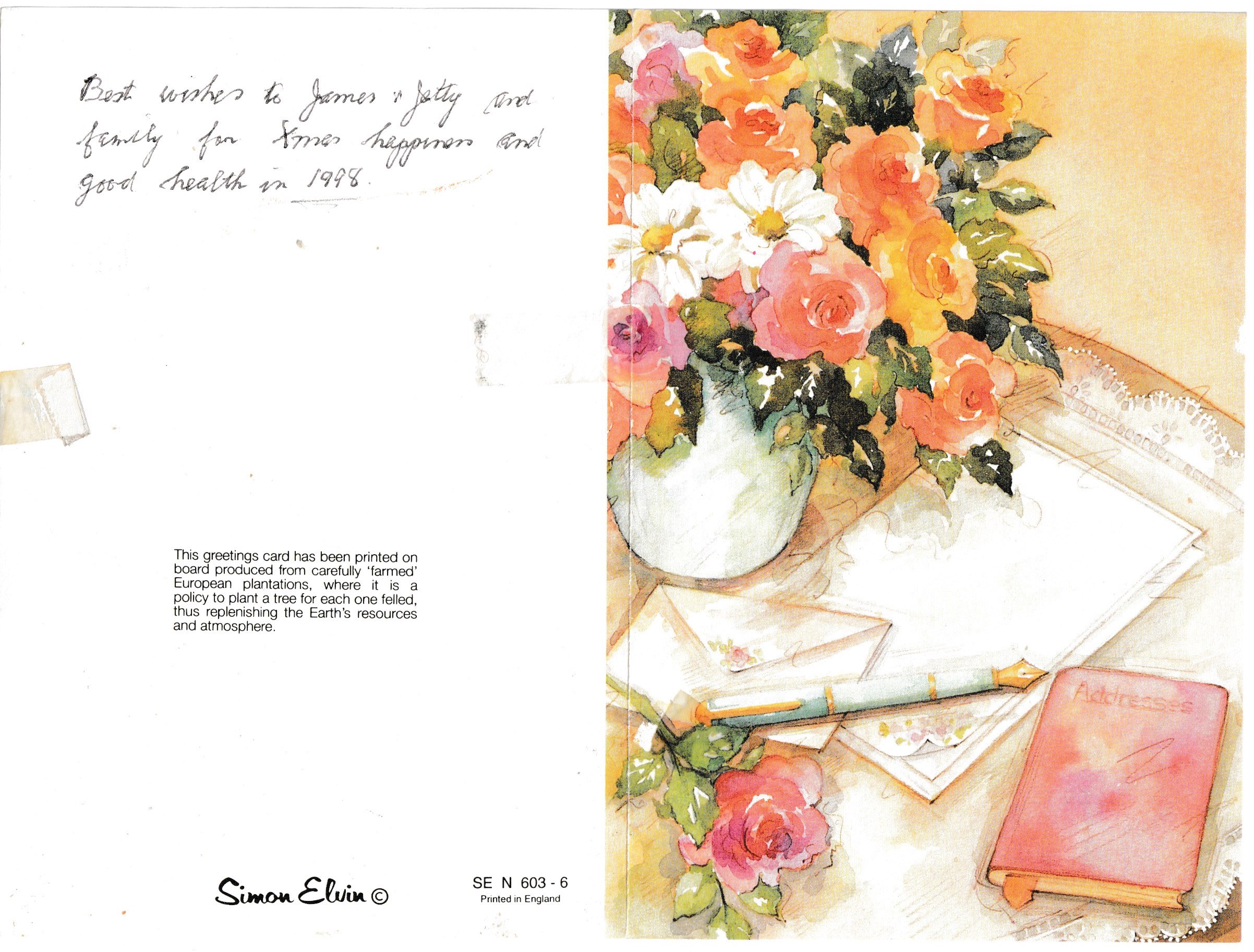 |
9 December 1997
[No address] Dear Jim, Many thanks for your newsletter of 16/12/96. You certainly work hard at your studies, as does Evelyn Hay at her History of Art. I hope Jetty and Michael completed the re-decoration of the house satisfactorily. Frans and Yvonne would have a lot to tell you about Australia. A great many people I know have been there. A century and more ago some of my mother’s relatives emigrated to it and “disappeared”. |
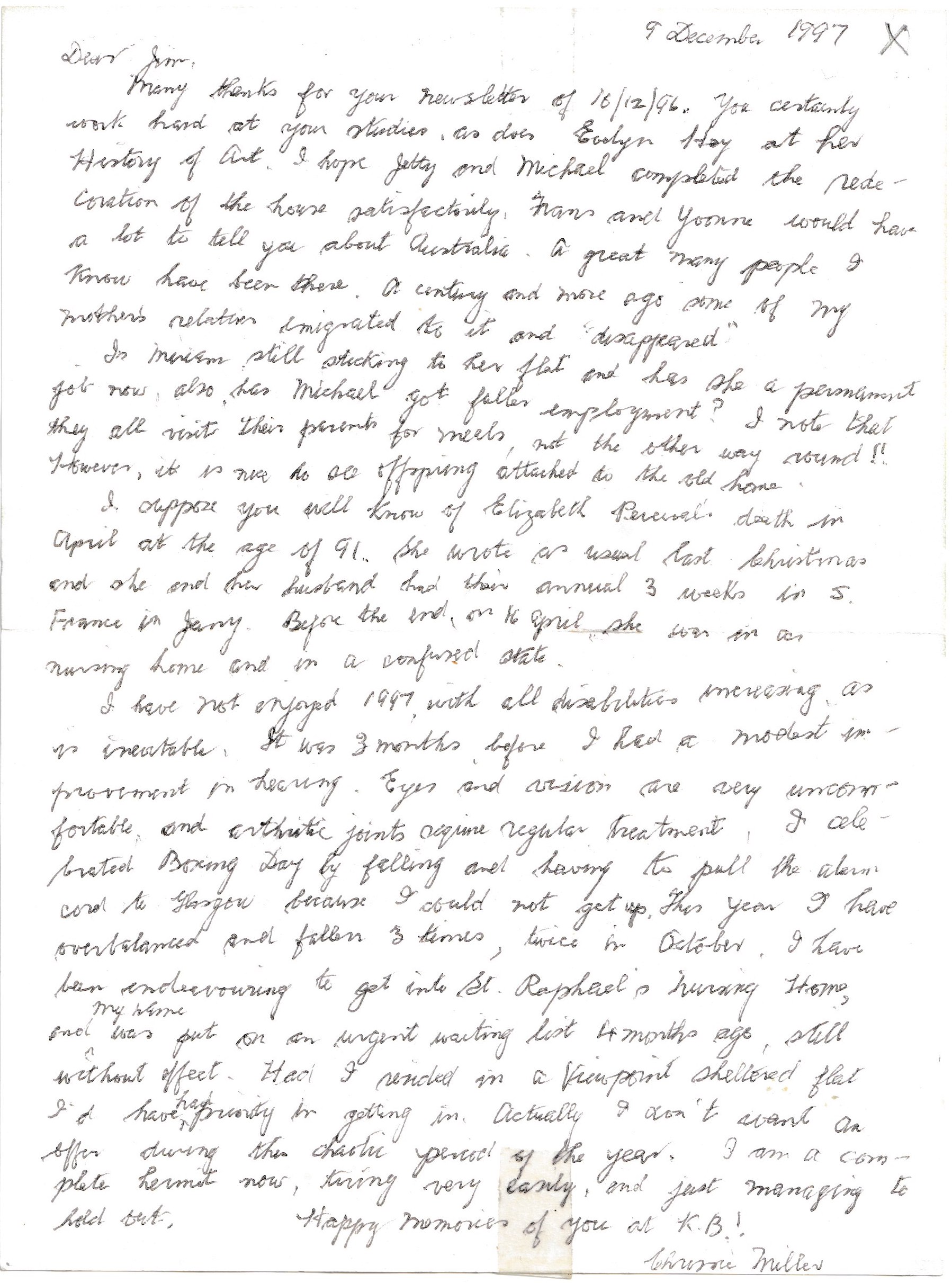 |
Is Miriam still sticking to her flat,
and does she have a permanent job now, also, has
Michael got fuller employment? I note that they all
visit their parents for meals, not the other way
round! However, it is nice to see offspring attached
to the old home. I suppose you will know of Elizabeth Percival’s death in April at the age of 91. She wrote as usual last Christmas and she and her husband had their annual 3 weeks in S, France in Jany [sic]. Before the end, on 16 April, she was in a nursing home and in a confused state. I have not enjoyed 1997, with all disabilities increasing, as is inevitable. It was 3 months before I had a modest improvement in hearing. Eyes and vision are very uncomfortable, and arthritic joints require regular treatment. I celebrated Boxing Day by falling and having to pull the alarm cord to Glasgow because I could not get up. This year I have overbalanced and fallen 3 times, twice in October. |
Chrissie Miller.
[On the reverse of the card] Best Wishes to James & Jetty and family for Xmas happiness and good health in 1998.
Addendum 3: A
Valentine’s picture postcard with six views of Old
Edinburgh.
There is no date discernible. C.f. letter no. 15 published earlier on my website, dated 28 November 1998, and addressed from St Raphael’s.
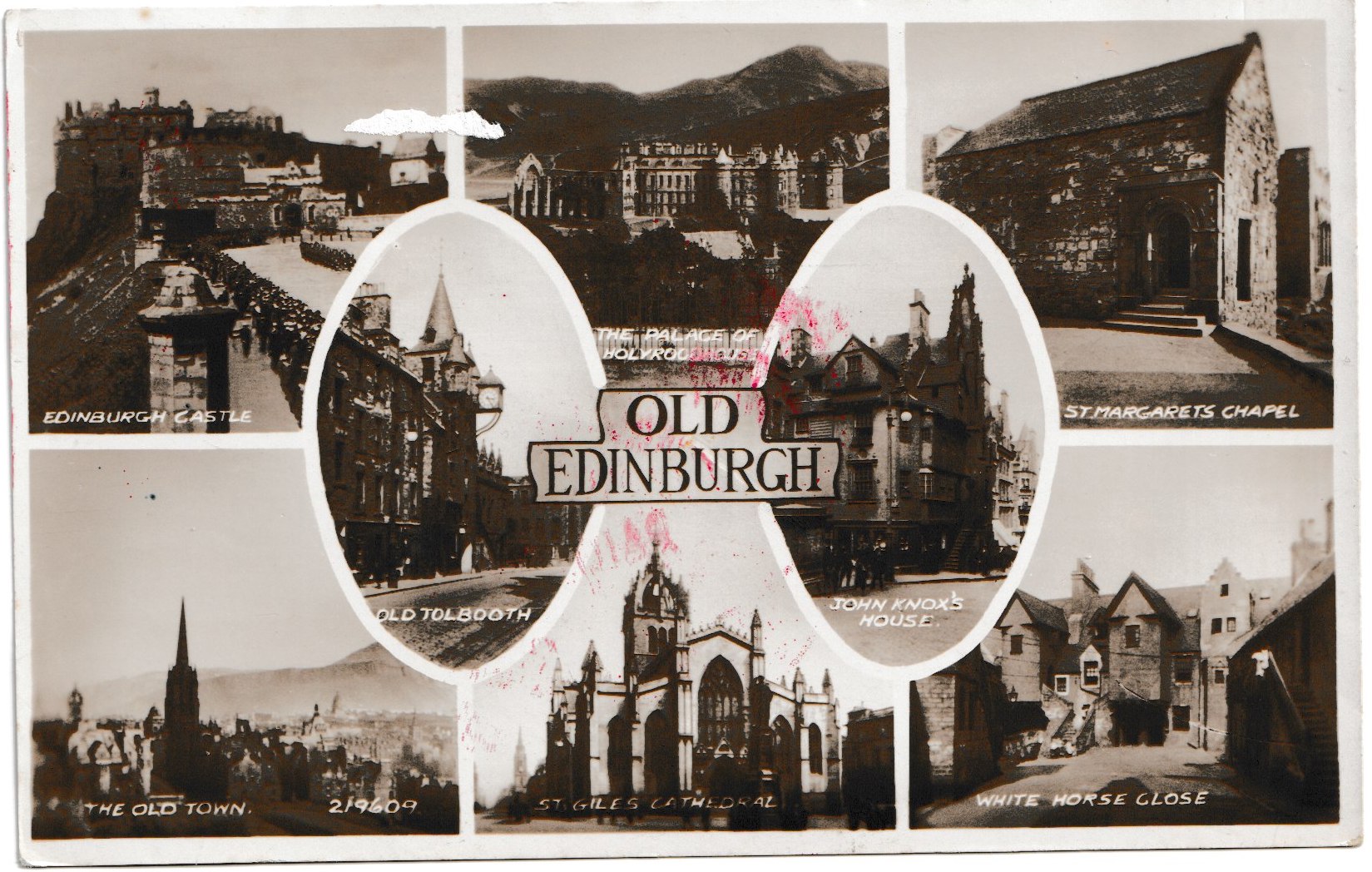 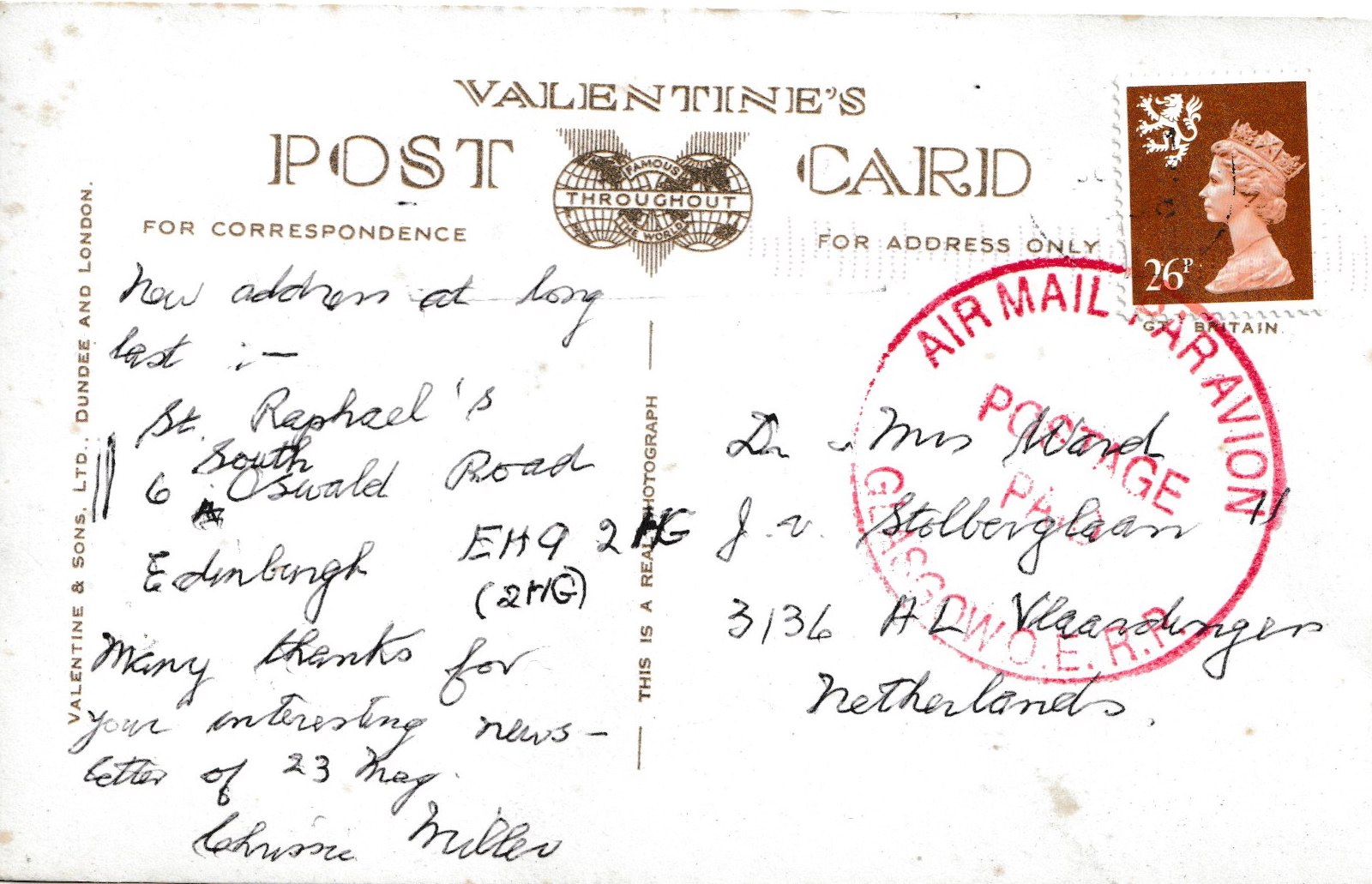 |
New address at long last: St Raphael‘s, 6 South Oswald Road, Edinburgh EH9 2HG. Many thanks for your interesting news-letter of 23 May. Chrissie Miller |
See all twenty one personal letters by Dr Christina Cruickshank Miller.
Emperor Maximilian I and
his Generals in Holland and Brabant (1506-1515)
during the Guelders War
James P. Ward
|
A number of reasons are adduced here for the failure of Emperor Maximilian I to achieve a settlement with his adversary Charles, duke of Guelders, in the long drawn out war for possession and mastery of Guelders.
|
||
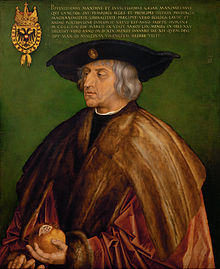 Emperor Maximilan I of Habsburg (1459-1519) |
Stadholder Jan III van Egmond (1438-1516) |
|
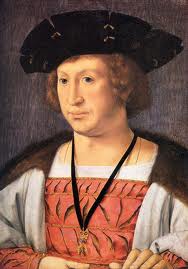 Stadholder Floris van Egmond (1469-1539) |
Stadholder Jan II van Wassenaar (!483-1523) |
Sources are
described in James P. Ward, The Cities and
States of Holland (1506-1515). A participative
system of government under strain.
Dissertation Leiden University, 2001, and are
collected and published as RGP 259 in Bronnen
voor de geschiedenis der dagvaarten van de
Staten en steden van Holland voor 1544
(Sources for the history of the diets of the
States and cities of Holland before 1544) Part VI:
1506-1515; collected and compiled by J.W.J.
Burgers, J. P. Ward and J.G.Smit, The Hague, 2006. READ MORE |
LETTERS FROM DR CHRISTINA CRUICKSHANK
MILLER
(1899-2001)
James P. Ward
This article contains twenty one personal letters by Dr Christina Cruickshank Miller
to J. P. Ward, a former student and pupil, written between 1984 and 2001,
the year in which she died aged almost 102.
Dr Christina C.
Miller
|
The saying 'Old
age is no place for cissies' is attributed
to Bette Davis (1908-1989). Chrissie Miller
(1899-2001) was no cissy. Her letters here contain
in a nutshell some of her own brief descriptions
from her long life, her training and study for
academic research in Chemistry, her many trials
through bad health, but above all her many
friendships. My purpose in publishing the letters is
to reveal something of Dr Miller’s character and her
life in her own
words. But she has been described well by
Dr Robert (Bob) Chalmers, who wrote especially of
how interested and how engaged she was in the
wellbeing of her former students and their families;
above all how intrepid she was, regardless of her
physical disabilities of sight and hearing. I
repeat, Dr Chrissie Miller was no cissy. Dr Christina Cruickshank Miller was recognized by her friends and colleagues and by her students to be a remarkable woman. I guess, everyone who ever met her has an anecdote to tell. Her career has been described in a number of articles. One author (Bob Chalmers, letter no. 10) remarked to her that the 2500 words he had been allowed by an editor could better have been 5000. Her wide ranging honours and distinctions were many. They included election to fellowship of the Royal Society of Edinburgh; the teaching laboratories at Kings Buildings were named in her honour; she was cast in a semi-fictional role in a modern chamber opera, “Breath Freely” by Julian Wagstaff; Dr Miller and her friend and colleague Mrs Percival, otherwise Mrs McDowell, née Ethel Elizabeth Kempson are included in Wikipedia’s Wikiproject Women Scientists. |
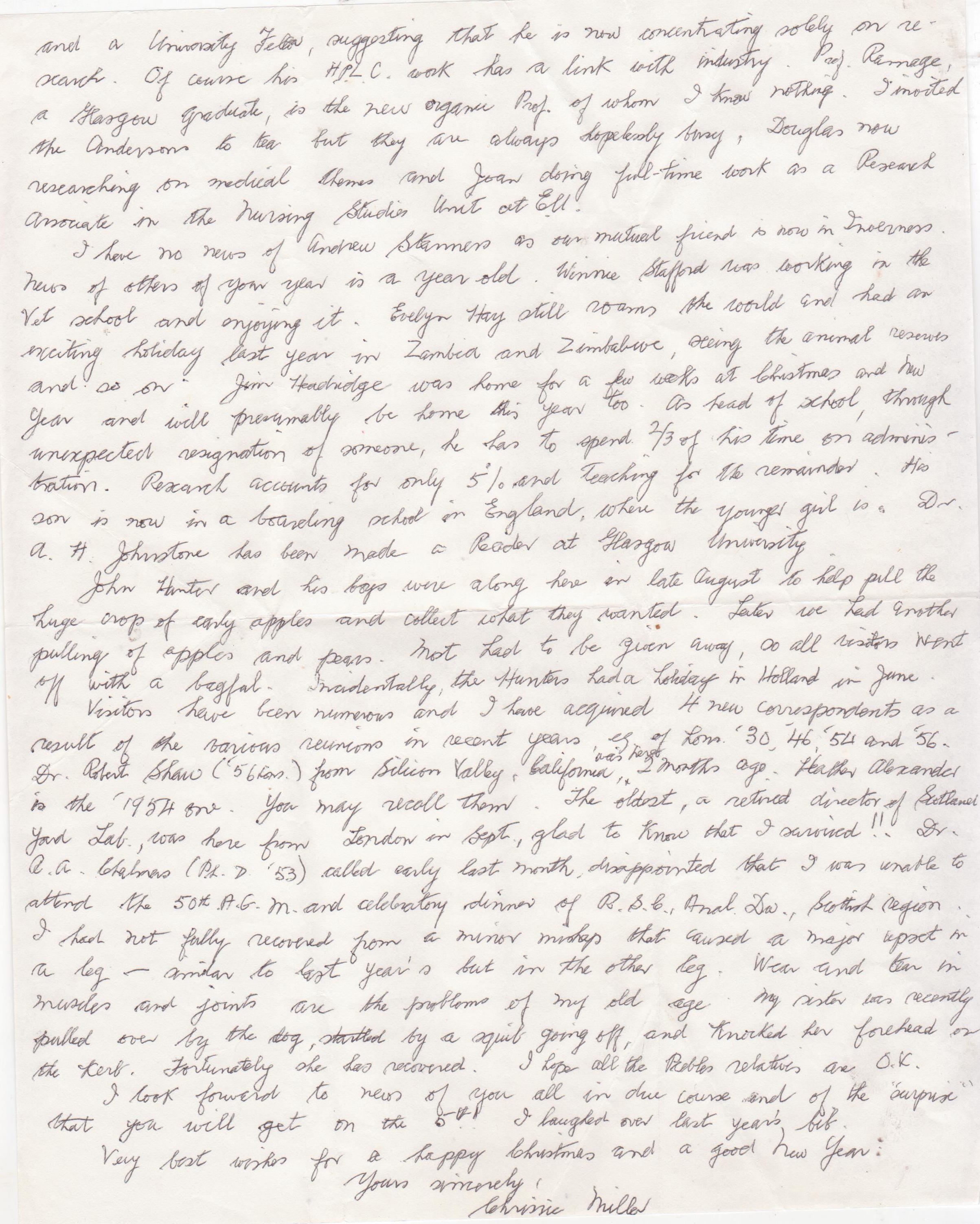 Dr Miller Letter of
2 Dec. 1984
See all twenty one personal letters by Dr Christina Cruickshank Miller |
I first encountered Dr Miller in my third year as student at Edinburgh University in the period 1949-1956. I say encountered, because the first occasion was at the start of a short series of lectures which she gave to undergraduates, on inorganic chemistry and analysis. Frankly, I cannot remember anything she told us in those lectures; and it wasn’t for want of trying.
Punctually each time she marched into the lecture theatre, placed her notes on the rostrum, and, with scarcely her head and shoulders visible, read from them at great speed, stopped, collected her notes and left the lecture theatre. I had the impression that most of her listeners were as stunned as I was.
But in my 4th year I did truly meet Dr Miller when I became one of a small group of students who were chosen to attend her laboratory where she taught inorganic and organic microanalysis. She was no longer a small distant figure speaking at us, she was a warm hearted, little old lady doing her best to make good students of us.
In those days there was a suburban railway line round the inner city of Edinburgh, and Dr Miller and I used it, leaving home from different stations, to get to the university Chemistry Department at Kings Buildings (KB). So on many days in the following years we walked together the last uphill mile or so to reach the lab. In that time I worked as a demonstrator in Dr Miller’s lab, and I completed my Ph. D. study, with Dr W. H. Stafford as research adviser.
I presume it was shortly after my graduating and leaving KB in 1956 that we started corresponding. Dr Miller’s earliest extant letter to me is dated 2 December 1984. However, an earlier memento of her is a wedding present which my wife and I bought with a cheque which Dr Miller sent us on our marriage in 1962. Any early letters I may have received from her during five years I spent in Germany are lost.
Readers will find in her letters no references to details of chemistry. Instead, for future biographers there are references to the start of Dr Miller’s career, and her gratitude to Professor Sir James Walker (1863-1935). In the obituary notice for the Royal Society of Edinburgh, Bob Chalmers wrote that she received instruction in soda-glass blowing from a Mr Walter Murray in the period 1921-1924, and twice in conversations at her Craiglockhart home she remarked to me that she had spent some time at Leiden in Holland where she had also received instruction in glass blowing. I presume now that she referred to the more difficult techniques required in working with silica glass and an oxygen-fed flame.
I regret not having asked her for more information about that. However, I think, on good grounds, that she probably attended the laboratory and the unique school for chemical technicians, founded by Nobel Prize winner Kamerlingh Onnes at Leiden; cf. Dirk van Delft, “Heike Kamerlingh Onnes ”, publ. Amsterdam, 2005, where in Chapter 10, especially pp. 309-310, the importance of glass blowing taught at the school is emphasized. Kamerlingh Onnes was also known for his hospitality towards foreign scientists.
In one of her letters here (no. 14) Dr Miller remarked that she had started to carry out genealogical research into her family background, but that she was hindered therein by her poor health. Did she leave any record of that work? If so it would certainly interest biographers, but her last papers may have suffered the same fate as her once famous “Black Books” (cf. Chalmers’ obituary for her). Dr Miller herself told me in her Craiglockhart home, that just before leaving KB she had burned the books containing the analytical data and records of many years of research teaching which she and her students had carried out. “I asked”, she said, “but nobody wanted them. One day I took them down to the basement and threw them into the oven”. Remembering the reverence with which those sibylline-like books were treated in the past, I was aghast. But in letter no. 8 here she appeared resigned to the fact that since her retiring from work and study much of it had become “obsolete”, superseded by developments brought about by newer methods and newer instrumentation.
Sources
I append here summarily a short list of readily available on-line sources for the life, work and death of Dr Christina Cruickshank Miller, born 29 August 1899, died 16 July 2001, and for some of her best known colleagues, friends and students.- Robert A. Chalmers, “A mastery of microanalysis”,
Chemistry in Britain, June 1993, pp. 492-494, referring
to Dr Miller.
- Robert A. Chalmers, “Chrissie Miller”, The Guardian newspaper, 30 July 2001, similarly.
- Robert O. Gould, “Dr Christina Miller”, The Scotsman
newspaper, 6 August 2001.
- In Wikipedia (and refs cited there): Christina
Cruickshank Miller; Sir James Walker (chemist); James
Pickering Kendall; Sir Edmund L. Hirst; Robert J.
Ferrier.
- “Former Members of the Royal Society of Edinburgh,
1783 -2002” (abbreviated FMRSE), are listed
alphabetically under Obituaries, Royal Society of
Edinburgh. They include entries for Neil Campbell,
Edmund G. V. Percival, C. A. Beevers and Mowbray
Ritchie. Robert (Robin) Ferrier is listed as a Fellow,
for whom an obituary is expected to follow.
- Prof. D. J. Manners’ obituary for Mrs Elizabeth Ethel
Percival née Kempson in FMRSE contains names of other
persons of Dr Chrissie Miller’s generation.
- Professors Walker, Kendall and Hirst were Fellows of
the Royal Society (London) in whose records there are
obituaries for them:
- Sir James Walker’s, by Prof. J. P. Kendall, Biogr.
Mems Fell. R. Soc. 1 (Dec. 1935), published online;
- Prof. Kendall’s is by N. Campbell and C. Kemball,
Biogr. Mems Fell. R. Soc. 26 (Nov. 1980) pp. 255-273;
- Sir Edmund Hirst’s, by M. Stacey and Mrs Elizabeth Percival: Biogr. Mems Fell. R. Soc. 22 (Nov.1976) pp. 136-138.
Other sources
- Robert and Sheila Gould, “Cecil Arnold Beevers”,
Crystallography News, No 76, March 2001, pp. 17-18.
- Mary R. Masson “Robert Alexander Chalmers” published
in Talanta 72 (2007) 863-864.
- Richard Furneaux and Sarah Wilcox, “Robert John (Robin) Ferrier”, online at www.royalsociety.org.nz; see Obituaries there.
Other Literature
- Marelene Rayner-Canham and Geoff Rayner-Canham,
“Chemistry Was Their Life. Pioneer British Women
Chemists 1880-1949’’, Imperial College Press (2008),
especially pp. 286-288 (Chistina Miller) and pp. 289-290
(Mrs Percival née Elizabeth Kempson).
- Julian Wagstaff, “Breathe Freely, a chamber opera in
two short acts to a libretto by the composer”, publ.
Europa Edition. Ltd, No. EUR0015 (2014). Excerpts from
the first performance at Edinburgh are online at
YouTube. The role of Dr Miller was sung by Laura
Margaret Smith, mezzo-soprano.
- D. van Delft, “Heike Kamerlingh Onnes”, loc cit. above.
The Letters
The letters presented no problems in transcription, and I hope to have reproduced them here faithfully without extensive editing. The last one was as neatly written as the first. Dr Miller complained now and then of pain in her wrists while writing, and it is obvious at places that she has touched the paper with her pen unintentionally. She herself corrected errors of omission by insertions in the usual way, using caret marks, while other errors she corrected by cancellations, ‘crossings out’. For one word she used spelling variants (hassle; hastle), Mr Ebbutt’s name she mis-spelled. I have transcribed those passages without regard to editing. On the other hand, I have omitted the home address of one of Dr Miller’s correspondents, and two telephone numbers.See all twenty one personal letters by Dr Christina Cruickshank Miller.
Names
In the following list of Dr Miller’s correspondents and their families I have omitted, with some exceptions, references to academic and honorific titles. Many of the persons named had studied under Dr Miller, and others were colleagues and friends. Most had qualifications in Chemistry. The letters themselves make the relationships to her clear. I have included in parenthesis to the names a reference to the first of Dr Miller’s letters in which the name occurs; and with the names of her most frequent visitors and correspondents the adverb passim. Mrs Percival and Mrs McDowell were the same person, née Ethel Elizabeth Kempson.ADAMS, Mrs Margaret, née Liddle; (18); ALEXANDER, Heather; (1); ANDERSON, Douglas, and his wife Joan; (1 and passim); ANDERSON, Frank B.; (9); BEEVERS, Cecil Arnold; (4 and passim); BUCHANAN, John and Grace née Davie; (7); CAMERON, Christine; (15); CAMPBELL, Prof. Neil, his wife, and his son Hamish; (8 and passim); CHALMERS, Prof. R. A.; (9 and passim); CHARALAMBOUS, George; (9); COWTAN, Mrs Rosemary K., née Thow; (7); EBBUTT, L.I.K.; (9); EHRLICH, Hans; (13); FERRIER, Prof. Robert; (9); HAY, J. Evelyn, (1 and passim); HEADRIDGE, James B., and his wife Anne, and children Ruth and Peter; (1 and passim); HIRST, Prof. Sir Edmund’s wife Lady Hirst; (3); HUNTER, John; (1 and passim); INCH, Miss; (2); KEMPSON, Ethel Elizabeth; see Mrs Percival, Mrs McDowell (passim); JOHNSTONE, Prof. A. H.; (1); KIDD, David,; (15); KNOX, Prof. John, and ‘his second son’; (7); LACOURT, Dr Alice; (6); LEARMOUTH, George;(2); LESLIE, Louise; (4); MACBEAN, Dr Betty; (3); McDOWELL, Mrs Elizabeth. See Mrs Percival (passim) and KEMPSON, Ethel Elizabeth; MANNERS, Prof. D. J.; (2); MARKS, Angus; (3); MILLER, Alice, Dr Chrissie Miller’s sister; (2); MORGAN, Mrs Clare, née Wylam; (3); PERCIVAL, Mrs Elizabeth (2 and passim). See also KEMPSON, Ethel Elizabeth; REID, brothers Kenneth and David; (11); RAMAGE, Prof. Robert; (1); RASHBROOK, R. B.; (7); RENNIE, Mrs Myra, née McDougall; (2); RITCHIE, Mowbray, his wife Janet and his sister Margaret (2 and passim); SANDERSON, Miss Anne; (8); SHEDDON, Mr; (15); SHAW, Robert; (1); STAFFORD, Mrs Winnie L., née Galloway, her brother-in-law and sister Mr and Mrs Macpherson; (1 and passim); STANNERS, Andrew H., his wife and children Elinor, John and Adam; (1 and passim); THOW, David; (12); WILSHIRE, J. F. K; (4); WALKER, Prof. Sir James; (8); WYLAM, Clare. (3); see Mrs Morgan;
Security and Insecurity,
Spies and Informers in Holland During the Guelders War
(1506-1515)
James P. Ward
In 1471 Arnold duke of Guelders borrowed 300,000 gold guilders from Charles the Bold of Burgundy and pledged his duchy as security. Arnold failed to repay the loan. When he died in 1473 Charles the Bold foreclosed and assumed the title and rights to the duchy. First Arnold’s son, Adolf, attempted to recover Guelders by negotiation, and then his grandson, Charles of Guelders by military force. Their opponents were Charles the Bold’s heirs and successors: Emperor Maximilian I of Habsburg, his son Philip the Fair, and grandson emperor Charles V. After half a century of intermittent fighting, the matter was settled to Habsburg’s advantage, following the death (from natural causes) of Charles of Guelders in 1538.
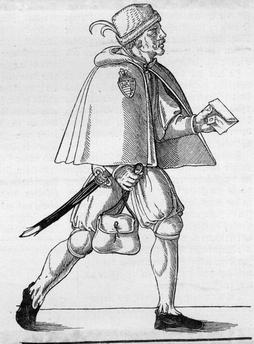
Many of the diets of the States of Holland from 1506 to 1515 were devoted to the question of how the frontiers of Holland with Guelders were to be defended. Articles describing the diets are published on this web site (see below). This most recent article describes ways and means by which the government of Holland and the Burgundian Low Countries and the magistrates of cities and towns sought to defend themselves from attacks by Charles of Guelders. The topics are: physical defence works like weapons, gates, walls, and towers; security measures to curb the movements of travellers and strangers; military intelligence, espionage and counter-espionage; and diplomacy with the help of open and of secret friends and allies.
Some conclusions are:
- the city magistrates of Holland used their considerable economic power to provide conventional defences like weapons and fortifications against Charles of Guelders’ attacks;
- travellers and strangers were required to be registered by innkeepers and church wardens on the grounds that they might be spies; conversely, the magistrates of Holland themselves employed spies locally. For example, their couriers were required in times of crisis and rumour to reconnoitre the enemy’s movements. At different social levels “secret friends” along the borders and in the enemy territories, Utrecht and Guelders, were paid sometimes large sums, sometimes small sums of money for information they provided about enemy plans and movements;
- diplomacy was a line of defence affecting and promoting both military security and Holland’s foreign trade and prosperity. Foreign powers like Denmark and the Baltic city states corresponded directly with the cities of Holland, and they with them.
READ MORE: Security and Insecurity During the Guelders War.pdf
Military Pay and
Taxation in Early 16th Century Holland during the
Guelders War
James P. Ward
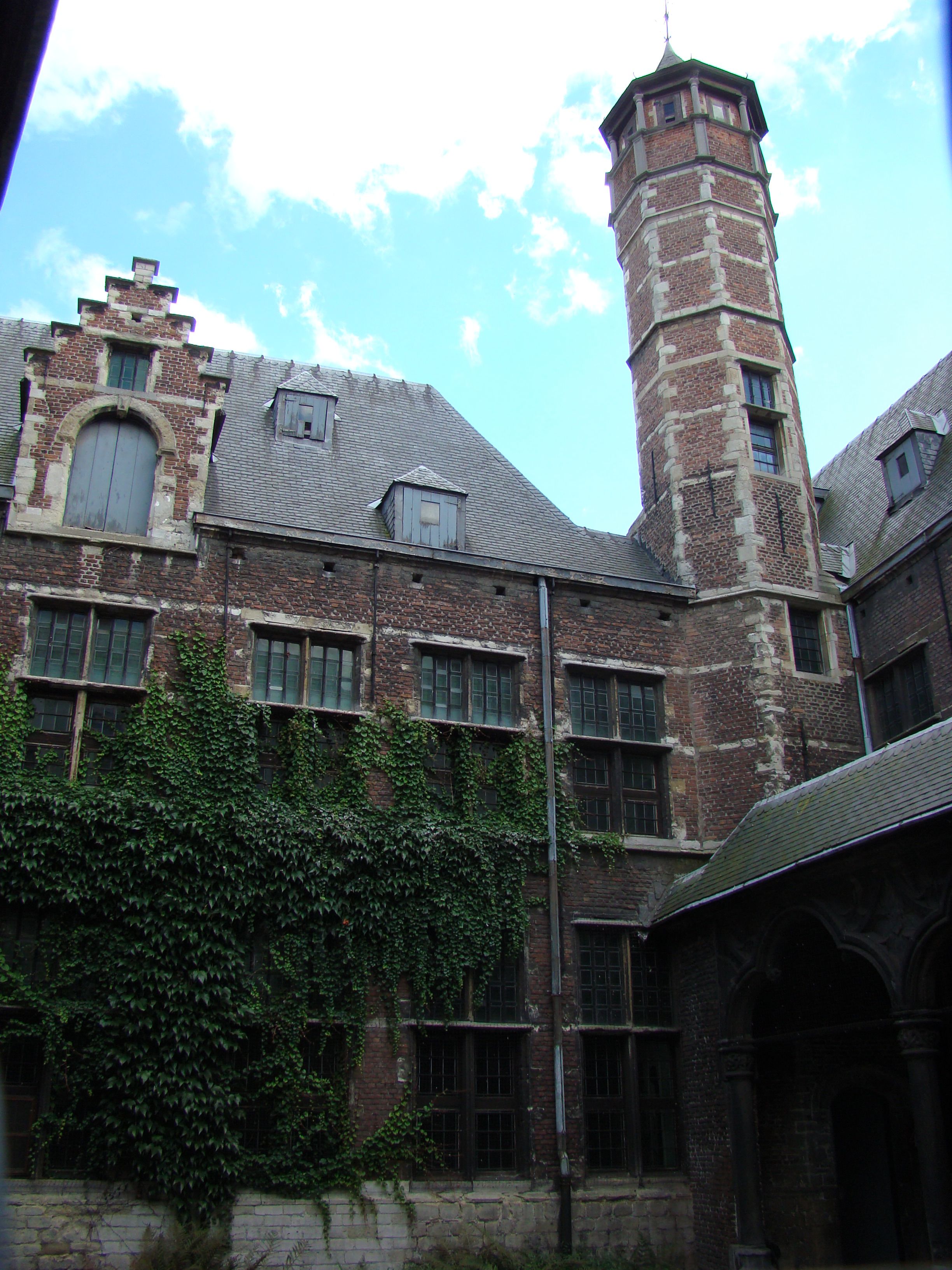
Illustrations here show the
Old Stock Exchange (Oude Beurs) at Antwerp,
still partly existing, and a public notice provided by
the Cornelis Floris Society which reads as follows:
OLD STOCK EXCHANGE
In the 15th century a stock exchange was housed in the
courtyard of a building called 'The Rhine'. The wooden
structure of that 'Oude Beurs' (Old Stock Exchange)
was renewed in 1515 with stone pillars. The “Pagadder”
Tower from which ships on the River Schelde could be
observed dates from the first half of the 16th
century.
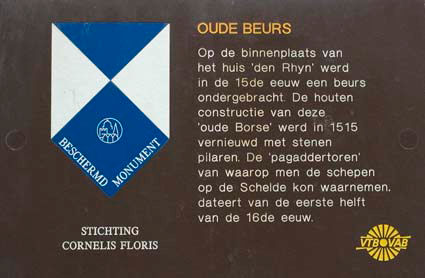
This article is based on early 16th century sources in the
archives of Holland. It contains data on pay scales to
different ranks of professional soldiers (landsknechts) in
the Burgundian-Habsburg armies at the time of the Guelders
War. The article also contains data on pay to civilians in
Holland guarding towns and cities against attack by
Guelders forces.
Costs of the war and the high level of taxation by
extra-ordinary aides are described. Two monetary
standards of payment, one in Philips Guilders and a 20
percent higher pay standard in Gold Guilders are revealed.
This led on several occasions to discontent among soldiers
on the lower rate, and to mutinies, several of which are
described. As a result of their opposition to the many
extra-ordinary aides needed to pay the soldiers,
the cities of Holland in 1507 won for themselves the right
to inspect the numbers of men engaged by the government at
The Hague, and to audit the accounts of the extra-ordinary
aides.
As the war intensified the government, with the cities of
Holland as guarantors, borrowed increasingly large sums of
money from merchant bankers in order to pay the soldiers
it hired. By this arrangement the cities of Holland had to
make legally binding agreements with the bankers, pledging
their contributions to the extra-ordinary aides
to pay the interest on those loans. Consequently, from
1512 onwards there was a transition to a system of long
term public borrowing. In the early 16th century two
merchant bankers from Antwerp were active in arranging
loans in Holland; Hieronymus (Girolamo) Frescobaldi, and
Balthazar Busin.
READ MORE: MilitaryPayandTaxation.pdf
Louise von Baden and
Christoph von Schmid’s “Biblische Geschichte”
James P. Ward
The book which is shown in photographs below is
believed on circumstantial evidence to have belonged to
Princess Louise Amalia Stephanie (1811-1854), Princess of
Baden, and subsequently to her brother-in-law William,
11th duke of Hamilton (1811-1863), whose wife was Maria
Amalia Elisabeth Caroline (1817-1888), Princess of Baden,
dowager duchess of Hamilton.
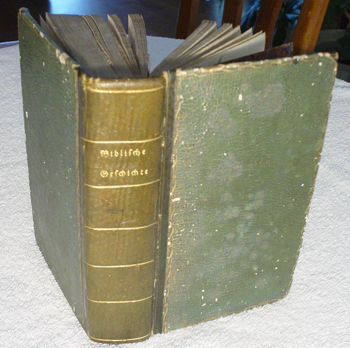 |
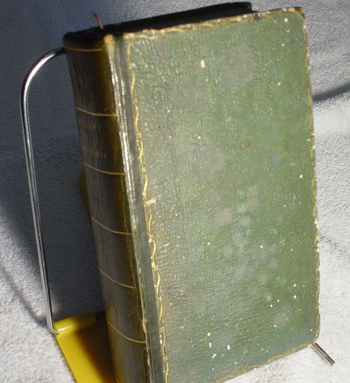 |
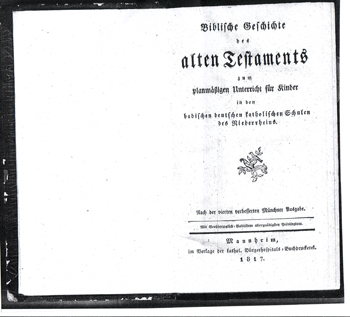 |
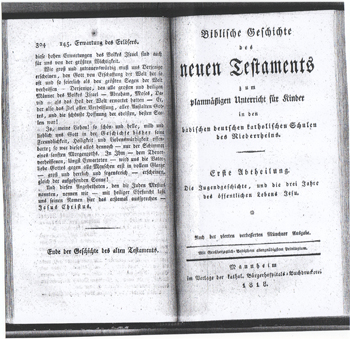 |
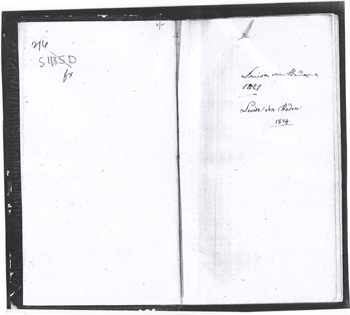 |
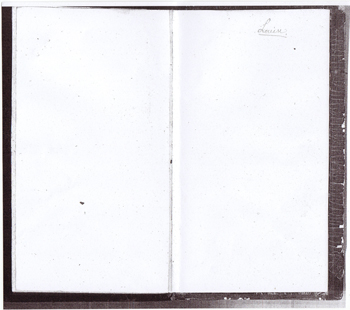 |
Click on the images for a large view
READ MORE: Louise von Baden and Christoph von Schmids Biblische Geschichte.pdf
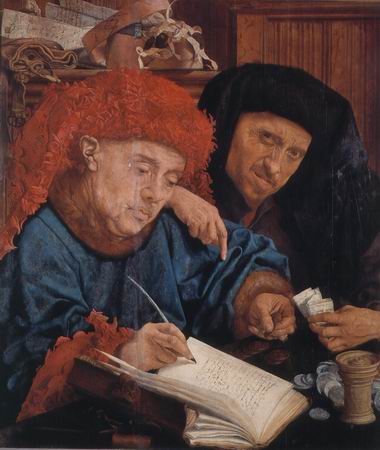
The Tax Collectors
attrib. Reymerswaele
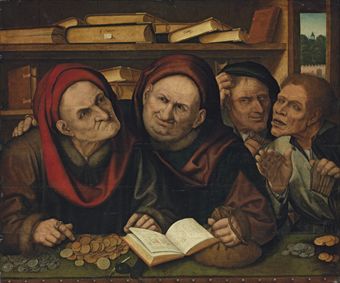
Suppliants in the office of two tax collectors
This article (here with its original
title and with the references in the footnotes included
in full at the end) was printed and published as J. P.
Ward, "Hostage taking (Gijzeling) in Early
Sixteenth Century Holland, and the Guelders War" in: L.
Sicking and M. Damen (eds), Bourgondie voorbij. De
Nederlanden 1250-1650. Liber alumnorum Wim Blockmans,
Hilversum 2010; pp. 355-366.
Abstract: A major theme in the work of Wim
Blockmans is his research into early institutions of
popular representation in the Low Countries and in
Europe generally. Chief among those institutions in the
Low Countries from the late Middle Ages onward were the
States General and the States of the individual
provinces. Blockmans proposed a number of conditions
necessary for popular institutions of representation to
be successful, one of the most important of which was a
willingness of partners to negotiate agreement.
Consensus presupposes a state of law and order in which
the interests, rights and privileges of the citizen and
of the government are recognised and protected.
Blockmans listed sanctions which lay authorities in the
Low Countries in the late medieval and early modern
period could impose in order to maintain law and order.
Chief among them were corporal punishments, banishment,
enforced pilgrimages, the pillory, and money fines.
The sanctions named did not exhaust the authorities'
means to persuade or coerce its citizens to behave
themselves in a civil manner, because a milder measure
used was a form of hostage-taking or detention called
gijzeling. The article consists of two parts. The
first describes the procedure of gijzeling. The
second part describes the use to which the government in
Holland put gijzeling in the early sixteenth
century during negotiations with city magistrates about
the supply or aides. More exactly, the article describes
the enforced consent to and payment of extra-ordinary
aides for the Guelders war.
It is also proposed that the long delays caused by the
legal processes were a factor in the introduction in
1512 of a newer method of raising money for the
government by long term bankers' loans, where the
interest on the loans was paid by the cities of Holland
from the aides.
READ MORE: Ward, Gijzeling, Bourgondie voorbij.pdf
Keynesianism
before Keynes?
Unemployed weavers and a proposal made at Leiden in
1523
James P. Ward
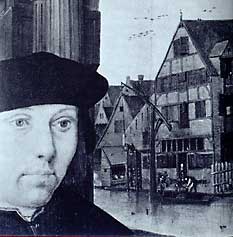
Dirc Ottensz, a burgomaster of Leiden ca. 1520
This
note
describes a proposal contained in anonymous letters to
the magistrates of
READ MORE: KeynesLeiden.pdf
Military
Drill and Words of Command. Queen Elizabeth II’s
“Spin-wheel” and Emperor Maximilian I’s “Snail”
James P. Ward
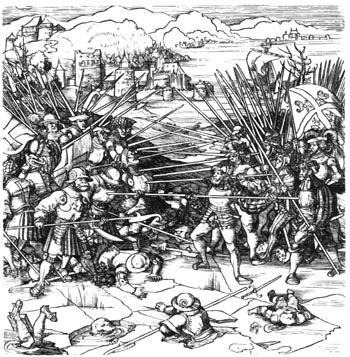
Landsknechts
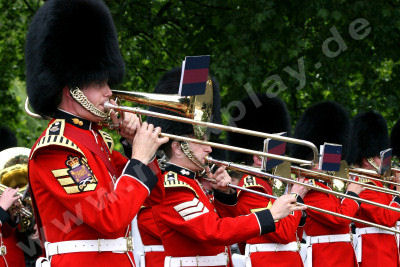
Guards Band
British sovereigns celebrate their official birthdays with an Honours List , and traditionally with a military parade called The Trooping of the Colour which is held every year on the second Saturday in June. There the sovereign presents new Colours and takes the salute of the regiments of guards at a march past on Horse Guards Parade in London. The parade with its ceremonial is shown on BBC television every year to millions of viewers worldwide. A detail is that at a certain point in the ceremony the massed bands of the guards are lined up, standing at attention on the parade ground, but as a result of earlier movements they are facing, as it were, “the wrong way”. The trombone players appear at the back, while the (bag)pipes and drums are at the front, the reverse of the normal order. But at a word of command the whole formation begins in slow marching time to make a massive turning movement which appears to be unique in the annals of military drill.
At that point in the proceedings television commentators invariably remark on how complicated the movement is, and how its origins appear to be unknown. Military men who are present to give advice to the television people, and to add comment for the viewers, are also at a loss to explain the origins of the drill. A website dedicated to the Trooping of the Colour affirms that “it is the responsibility of the Garrison Sergeant Major to ensure by rehearsals that it is executed correctly”, and moreover, “that it appears in no drill book or manual of ceremonial , but is passed down from memory to each new generation of bandsmen”. This appears therefore to be a prime example of oral history. It opens the way, moreover, for investigation into the origins of military drill movements in general, and especially this one called the “Spin-wheel” which is performed by the guards at the British sovereign’s official birthday parade.
READ MORE: spintwo.pdf
Participative government in
James P. Ward


Emperor Maximilian
I
Emperor Charles
V
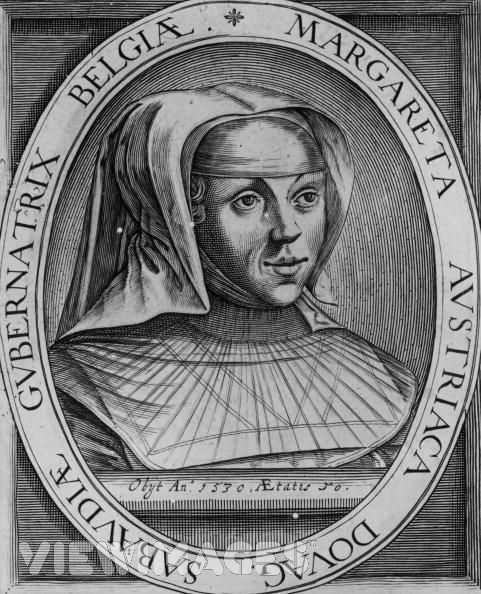
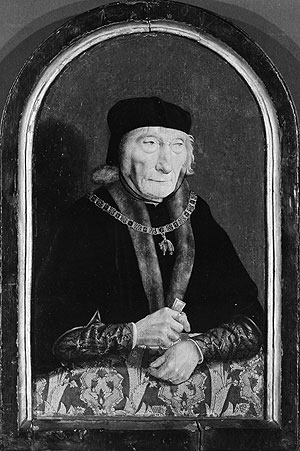
Regent Margaret
Stadholder
of
Austria
Jan
van Egmond
In common with other modern
states the
One of the oldest such institutions still
functioning is the Hoogheemraadschap of Rijnland, the
district surrounding
READ MORE: Participative government; LIAS (2004)
HADRIANUS BARLANDUS AND A CATALOG OF THE
COUNTS AND COUNTESSES OF HOLLAND PUBLISHED
AT AMSTERDAM BY DOEN PIETERSZ
James P. Ward
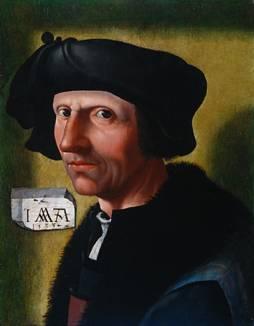
Jacob Cornelisz van Oostzanen
At the beginning of
the sixteenth century the printer Doen Pietersz
published a series of woodcuts by the artist Jacob
Cornelisz of Oostzanen (1470-1533), depicting the counts
and countesses of Holland from the tenth to the
sixteenth century. Editions of this `Catalogus’ are
known which are accompanied by anonymous texts in Latin
and in French which provide short biographies of the
persons depicted.
The series with texts in Latin is described here, and
questions which are addressed are: who was their author,
what were his sources, how accurate are the histories of
the counts and countesses, and how are they to be
evaluated as examples of early sixteenth century
historiography. It is shown that Hadrianus Barlandus
(1487-1539) was the author, and the so-called
`Divisiekroniek’ of Cornelius Aurelius (c. 1460-1531)
was probably his main source.
READ MORE: Barlandus. Humanistica Lovaniensia 2006
